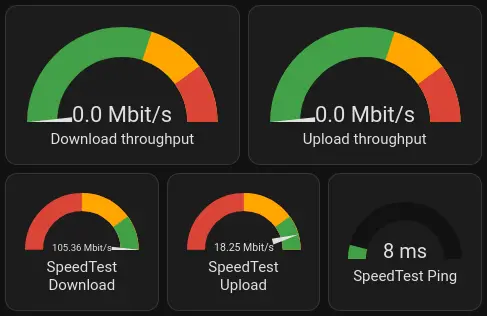I once changed a friend’s autocorrect from “regards” to “lots of love”.
And I somehow managed to keep my mouth shut long enough for a lecturer to get a very funny email.
I once changed a friend’s autocorrect from “regards” to “lots of love”.
And I somehow managed to keep my mouth shut long enough for a lecturer to get a very funny email.


I’ll just re-share mine from last time.
I tend to use the Horizontal Stack. On a mobile device, I just get one stack per line.
And on bigger screens, I get multiple stacks to make use of space.
General “Going out” page:

Internet speedtest page:



I’ll write a quick gist for anyone coming along:
One gas boiler in the house, each room has a smart TRV.
PIR sensor to set room presence, each window has an opening mag sensor.
HASS has a general presence sensor set.
Each room’s temperature is targeted based on presence and window status:
For each room, if person is home at all, and has been in the room for 5 mins, and the window is closed, TRV to 19, boiler on if <19.
If the room presence is negative and the window is closed, drop TRV target to 16.
If the window is open, drop the TRV target to 7.
There is a little more detail that that in the article, but that’s the basics.
“Diddja laak tha’?”
He’s having a little more fun in the original.
That doesn’t sound very typical.


z-wave may be easier than expected, as I think the devices stay linked to the hardware dongle used. (This is just from memory, mind!). But if you need to change the dongle, perhaps less fun.
imo, it will be a bit of pain to get everything inside HA, but once it’s done, you’ll be inside a platform that is pretty open, and commonly used, with lots of other people (hopefully) posting up solutions to problems before you encounter them!
And because it’s software that will run on pretty much anything, you have the reassurance that even if something crazy happened, you could just reinstall an old version.
If it were me, I’d clear an entire weekend day, power off the old kit, and work away at getting HA controlling everything.


Nice to see NC becoming involved with the board.
I don’t run that much z-wave due to cost, but I’m all for improvements and tighter integration.
Especially since when I do want to spend money, ZW works very well.


Or maybe something like this:
https://www.securemeters.com/uk/product/room-thermostats/hrt4-zw-asr/
The unit with the buttons on is a simple relay, which hass can control to turn things on and off, and use a heating control with a temperature sensor.
But if you hit the button on the front, it also gives 30 minutes of on, which can be handy if the system had issues.
Or you could have a hass controlled relay, but also leave the old controller wired in on a manual switch.
So if there was a failure, you could go back to the old control by manually flipping it over.
While not strictly a QR code, I always liked that the Dolby Digital data between perforations on a film strip had a tiny Dolby logo at the centre.
https://en.wikipedia.org/wiki/Sound-on-film#/media/File:35mm_film_audio_macro.jpg
It’s worth noting that most places without a “signature” style just use espresso as the base nowadays.
Because espresso is a much easier way to start (as it’s a small amount of coffee syrup, without the water).
And outside of speciality (pour-over/cold-brew), it’s the preferred extraction method.


The most expensive country on the med.
A low-wiring way to do it would be to replace the bulbs with hue/similar bulbs, then just put a battery powered button in the location you want to have the controls. £10-ish for each button, plus however much the bulbs are.
Then just have the button set to toggle the lights on/off (you can also call different presets like dim etc by pressing and holding).
Then hass just directly sends the on/off commands to the bulbs.
Piston aircraft still use it. Which makes it doubly annoying when some tit in a cesna decides to circle around town at 1000’.
Not just making a noise, also cropdusting with TEL.
Back to office.
I sharpen my knives with a grit block maybe every 6 months, because I want sharp knives, but was told an angle sharpener would leave me with BBQ skewers.
It’s hardly a “masterful man task”, more like 20 minutes to do a kitchen chore. Like refilling the dishwasher salt. Or cleaning the bin.
I guess in the services, the command chain is still there at night, if required.
3am food service, it’s just you, the other night-shifters, and 400 drunk people.
Any management with power is safely tucked up in bed.


My first integration is going to be putting my standard “going out” dashboard by the front door.
Being able to glance and see UV index, temperature, rain probability is dead useful.
With a bit of luck, native RTC support means 2-way comms using reolink doorbells is close at hand.